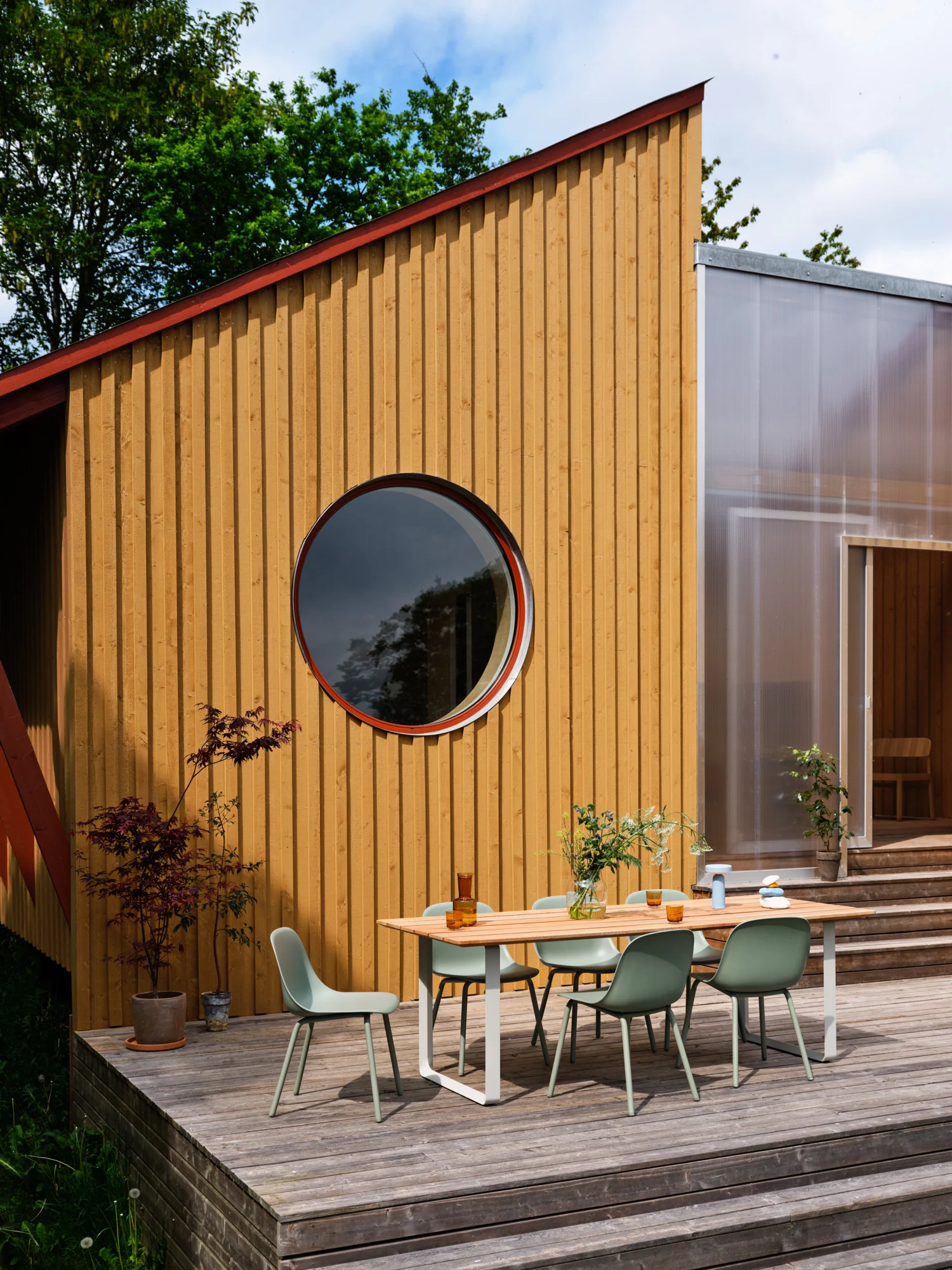
Mastering the Art of Outdoor Furniture Care
The Significance of Outdoor Furniture: Beyond Aesthetic Appeal
As we venture into the world of outdoor furniture and its care, it’s essential to acknowledge its evolving importance in our lives. Outdoor spaces have transcended their roles as mere extensions of our homes, blossoming into vibrant areas that echo our individual styles and serve as sanctuaries for relaxation. At the heart of these outdoor havens lies our outdoor furniture, thus elevating the beauty of our patios and gardens and, moreover, creating functional zones for entertainment, self-reflection, and rejuvenation. These pieces silently witness many of our cherished memories, from intimate gatherings to solitary moments basking under the sun or the stars.
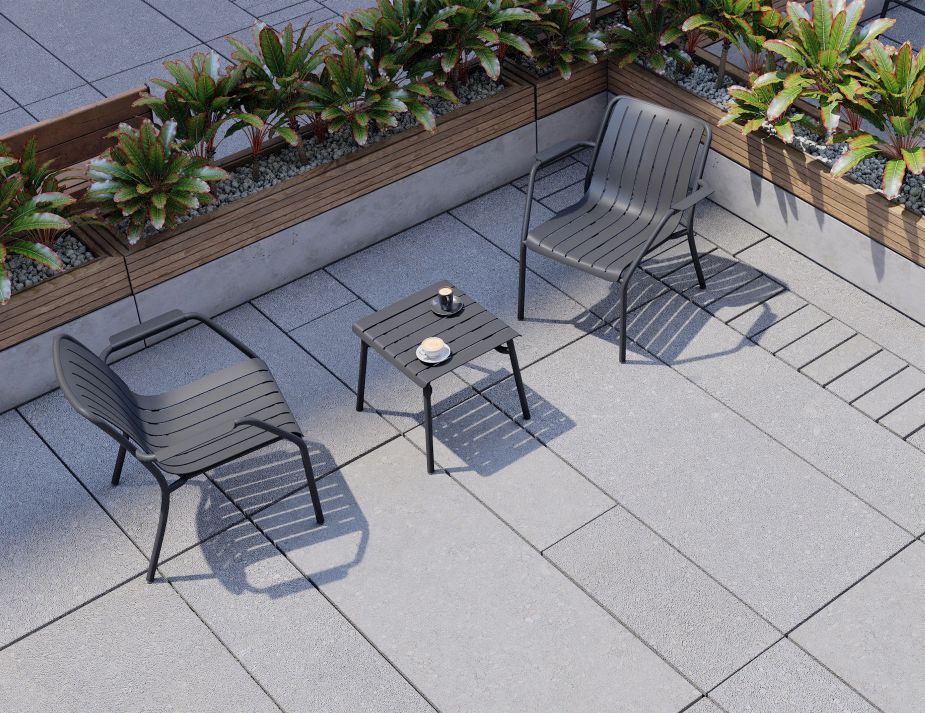
Guarding Against the Elements: The Imperative of Protection
Yet, like all valued possessions, our outdoor furniture comes with vulnerabilities. Exposed to the capricious whims of nature – the searing sun, sudden downpours, biting frost, and occasional visits from curious critters – these pieces face a myriad of challenges related to outdoor furniture care. Protection isn’t merely about preserving their visual allure; it’s a commitment to safeguarding their structural integrity and prolonging their lifespan. In essence, it’s a means of truly respecting and maximising our investment in these pieces, making proactive care an absolute necessity.
The Outdoor Furniture Care Guide: What Lies Ahead
In the following sections of this guide, we’ll delve deeper into the realm of materials for outdoor furniture and their unique susceptibilities. We’ll shed light on the common adversaries that pose threats to their well-being and, most importantly, equip you with a treasure trove of expert strategies, including DIY solutions, to ensure your furniture remains resilient in the face of time and the relentless elements. Whether you’re a first-time patio owner or someone seeking to revamp an existing outdoor haven, a wealth of insights awaits you in the pages that follow.

An Expert Guide for Choosing the Perfect Outdoor Furniture Material
Now, let’s delve into the core of outdoor furniture selection: the materials. The choice of materials not only influences aesthetics but also plays a pivotal role in determining the longevity and resilience of your outdoor furnishings. In this section, we’ll embark on a comprehensive exploration of various materials, spanning natural, metallic, and synthetic options. Our goal is to equip you with the knowledge needed to make informed decisions, ensuring the protection and preservation of your outdoor furniture investment.
Teak Wood
The epitome of durability and weather resistance, commands attention as an outdoor furniture material par excellence. Those seeking an enduring and low-maintenance solution find their answer in teak wood. To nurture your teak furniture, make the application of teak oil or sealant a ritual. These guardians of teak’s golden radiance ward off the ravages of the elements and maintain its weather-resistant properties.
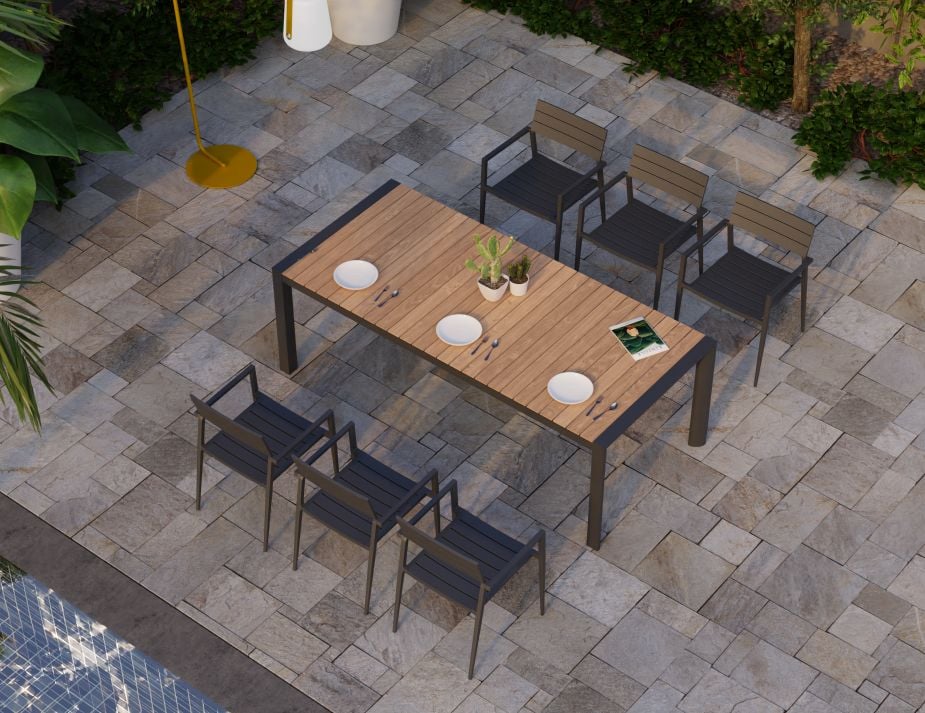
Rattan
Renowned for its flexibility and tropical allure, rattan stands as a beloved choice for outdoor furniture. Despite its organic charm, rattan remains susceptible to moisture and pests, making meticulous care and protection paramount. To safeguard your rattan pieces, adopt a proactive approach that involves regular cleansing and the application of protective coatings. These measures not only shield against moisture damage but also prolong the lifespan of your cherished rattan treasures.
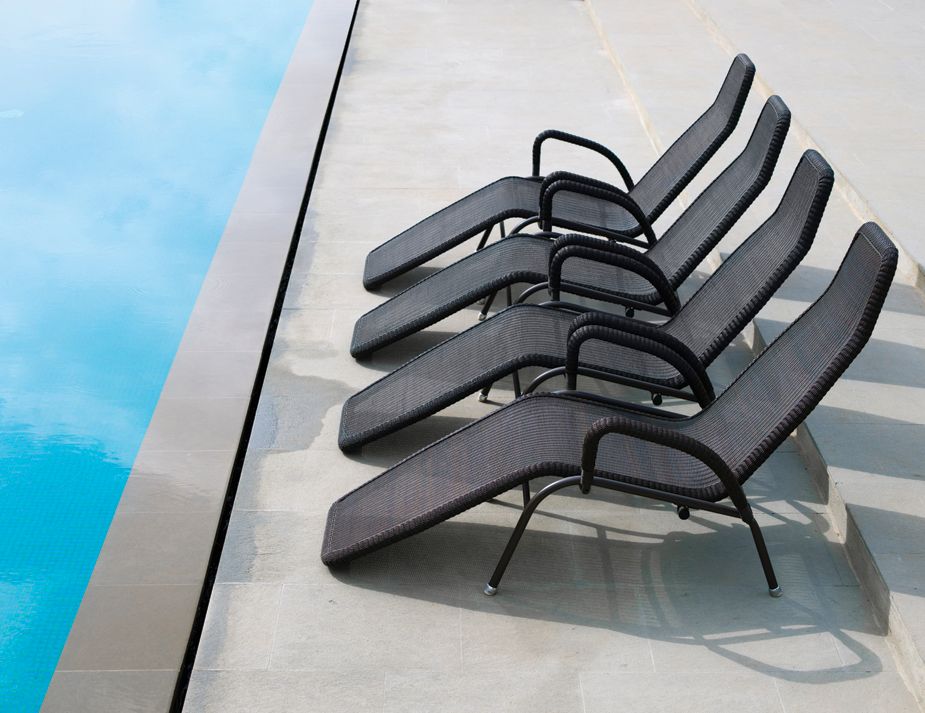
Spotted Gum
With its enchanting grain patterns and natural fortitude, spotted gum hails from the Australian landscape. This native hardwood is a natural choice for outdoor furniture, thanks to its imperviousness to decay and termite resistance. To protect outdoor patio furniture carved from spotted gum, reach for an outdoor timber oil or sealant. Concentrate your efforts on the exposed surfaces, where weathering poses the greatest threat.
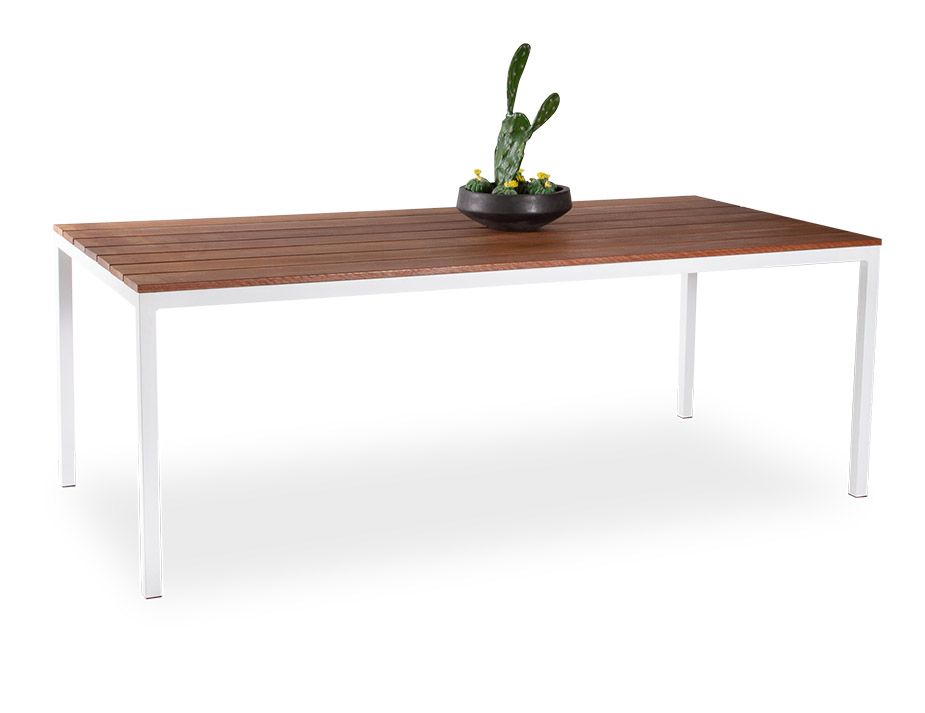
Aluminium
Renowned for its lightweight design and resilience to rust and corrosion, aluminium outdoor furniture stands as a favoured choice. To maintain the lustrous appearance and structural integrity of aluminium furniture, invoke a routine of regular cleaning with mild soap and water. Be on the lookout for signs of wear and address any pesky scratches with touch-up paint to ensure its continued allure.
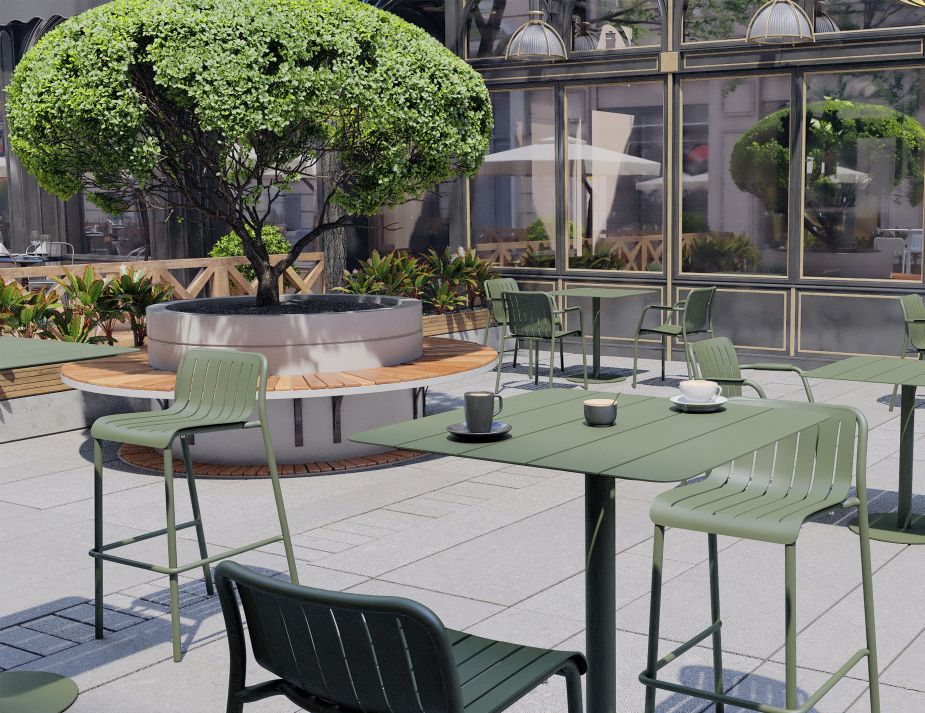
Steel
Stainless Steel, an emblem of durability and sturdiness, takes its place amongst outdoor patio furniture materials of distinction. However, the menace of rust may loom over steel if the protective finish falters. Safeguard your steel furniture through the application of a rust-resistant coating, preserving its resilience against the elements. Remember to keep it dry, denying moisture the opportunity to inflict damage.
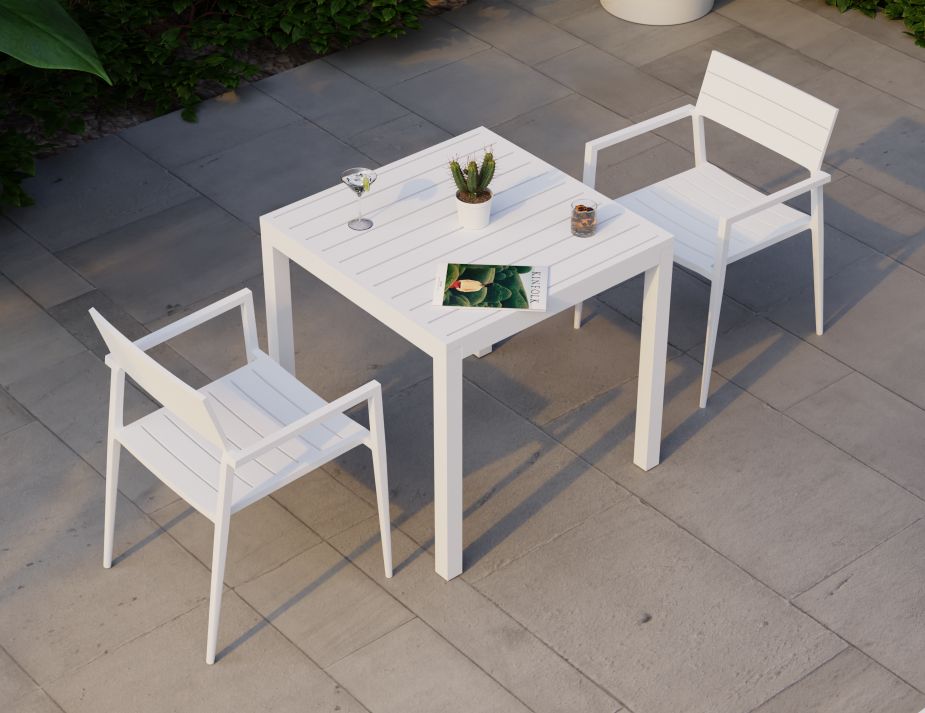
Plastic
Plastic outdoor furniture is a versatile and budget-friendly option. Its lightweight design makes it easy to move and rearrange in your outdoor space. Plastic is naturally resistant to moisture, making it ideal for humid climates. To protect plastic outdoor furniture, simply wipe it down with a mild soap and water solution to remove dirt and grime. Regular cleaning and occasional inspections for signs of wear ensure its longevity. The beauty of plastic is its low-maintenance nature, requiring minimal effort to keep it looking its best.
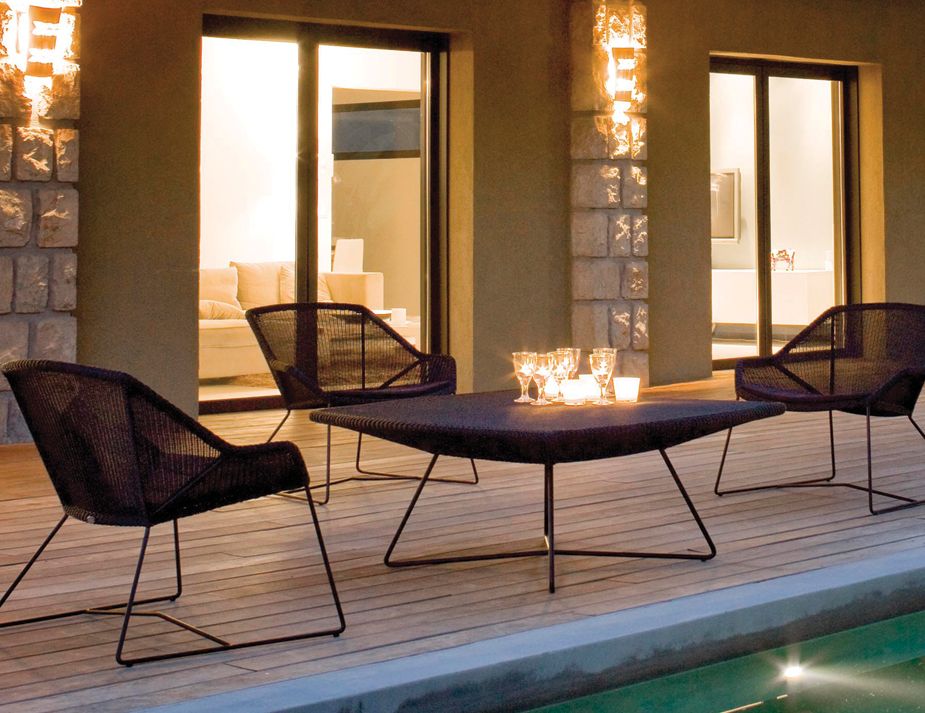
Rope
Rope-based outdoor furniture combines synthetic fibres with contemporary designs to create visually appealing and comfortable pieces. This material is weather-resistant and easy to clean, making it a practical choice for outdoor use. To protect rope furniture, regularly clean it with a soft brush or vacuum to remove debris. If stains occur, use a mild soap solution and a soft cloth to spot clean. The rope is known for its durability, but occasional inspections for wear and tear can help address any maintenance needs promptly.
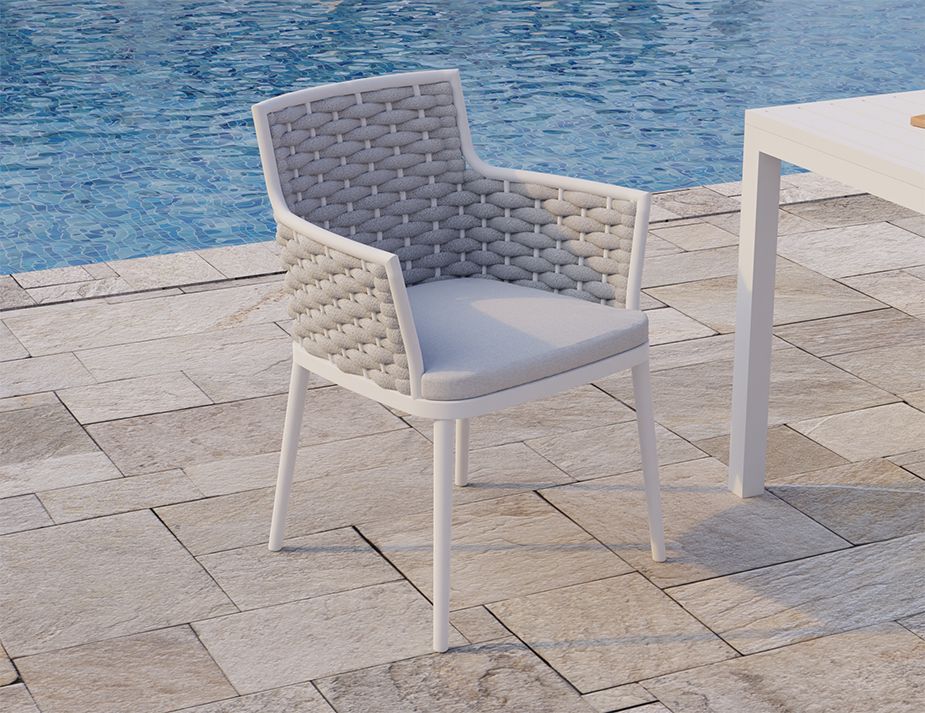
Matching Your Outdoor Furniture to Your Climate:
It’s important to choose furniture materials that fit your local weather.
| TYPE | DESCRIPTION |
| Hot and Dry | In sunny, dry areas, aluminium and plastic furniture are good choices because they handle heat and sun well. |
| Cold & Snowy | In places with cold winters, metal and plastic furniture are your best bet because they can handle the cold. |
| Humid & Rainy | In places where it often rains, synthetic outdoor wicker and plastic can handle the moisture. |
| By the Sea | If you live near the ocean, you need furniture that resists salt. Aluminium and teak are both good options. |
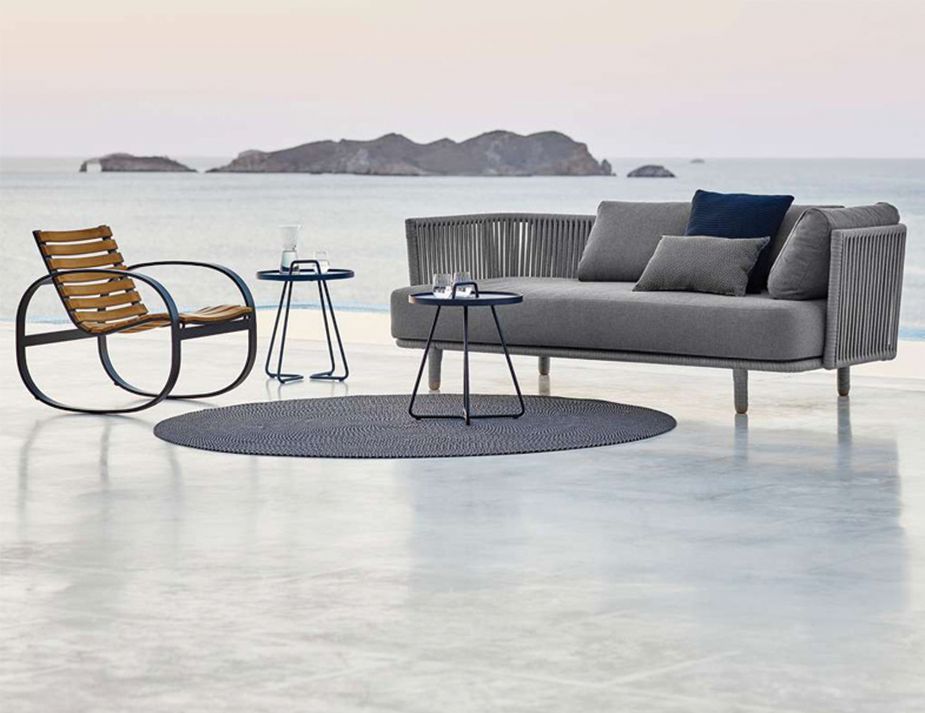
Outdoor Furniture Care: Overcoming Common Outdoor Challenges
As you revel in the creation of your dream outdoor space, the next chapter in this journey revolves around preserving that space and ensuring your outdoor furniture weathers the seasons, withstands capricious weather, and navigates unforeseen challenges. Let’s explore these familiar adversaries and uncover effective strategies to overcome them.
A. Understanding the Sun’s Impact on Your Outdoor Furniture
Fading Colours: The unrelenting sun can gradually rob your vibrant furniture of its original colours, rendering it pale and lacklustre.
Drying Hazards: Wooden furniture, in particular, is susceptible to the sun’s relentless assault, which can make it brittle and prone to cracks over time.
Sun-Proofing Strategies:
Consider investing in protective covers for your outdoor furniture. They act as a brilliant barrier against the sun’s direct rays, preserving the vibrancy of your pieces. For those with wooden furniture, embracing UV-resistant finishes is a savvy choice. These finishes can significantly extend the life and colour of your cherished pieces, ensuring they remain a vivid focal point of your outdoor space.
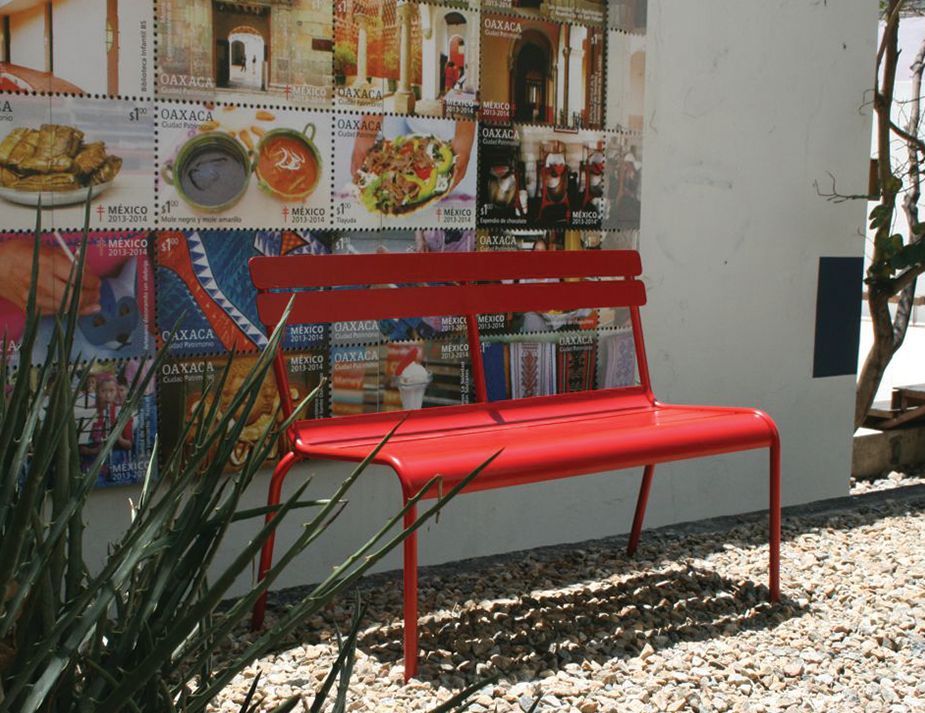
B. Combatting Moisture and Mould in Your Outdoor Paradise
The Rotting Challenge: Moisture has a sneaky way of infiltrating your outdoor furniture, silently weakening wood over time.
Mildew Threats: Wet and humid conditions often create ideal breeding grounds for mildew and mould, which not only mar aesthetics but can also pose health concerns.
Moisture-Combat Tips:
Consider materials like teak and synthetic weather wicker for their innate moisture resistance. They can help shield your furniture from the detrimental effects of excess moisture. Make it a habit to store soft components of your outdoor furniture in dry spots when not in use. This ensures they remain in top-notch condition and ready for your next outdoor gathering.
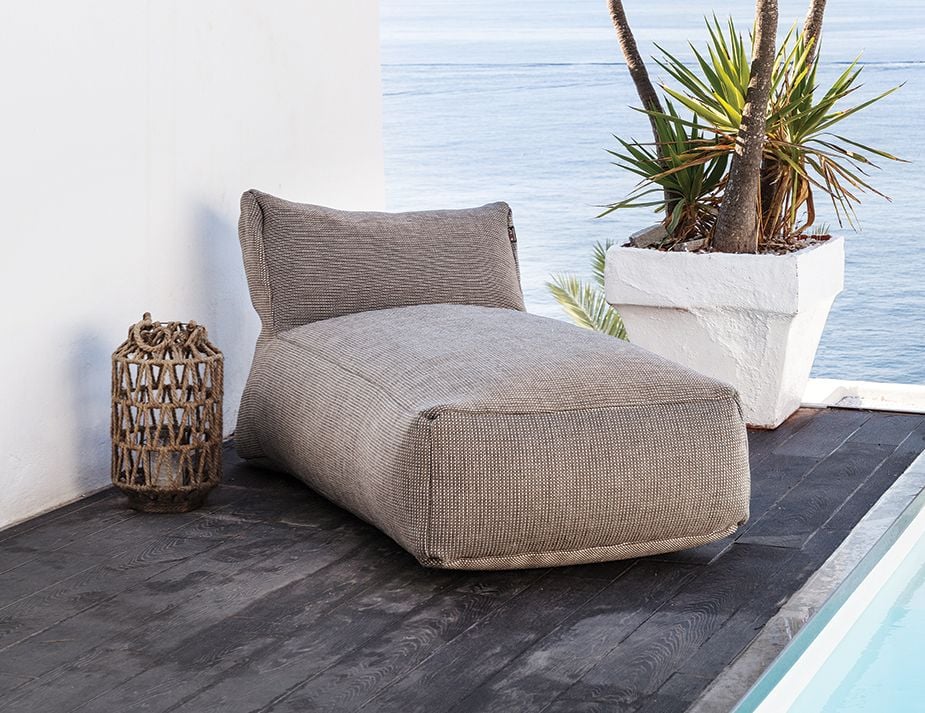
C. Safeguarding Furniture from Unwanted Pests
Insect Intruders: Creatures such as termites and ants often view wooden furniture as a delectable treat.
Rodent Challenges: Smaller animals, like mice or squirrels, might consider your cosy furniture cushions as prime real estate.
Pest Prevention Pointers:
Start by employing natural repellents such as cedar or citronella to deter pests from taking up residence in your outdoor furniture. Regularly inspect your furniture for any signs of infestations. Early detection can make it easier to address and halt pest problems before they escalate.
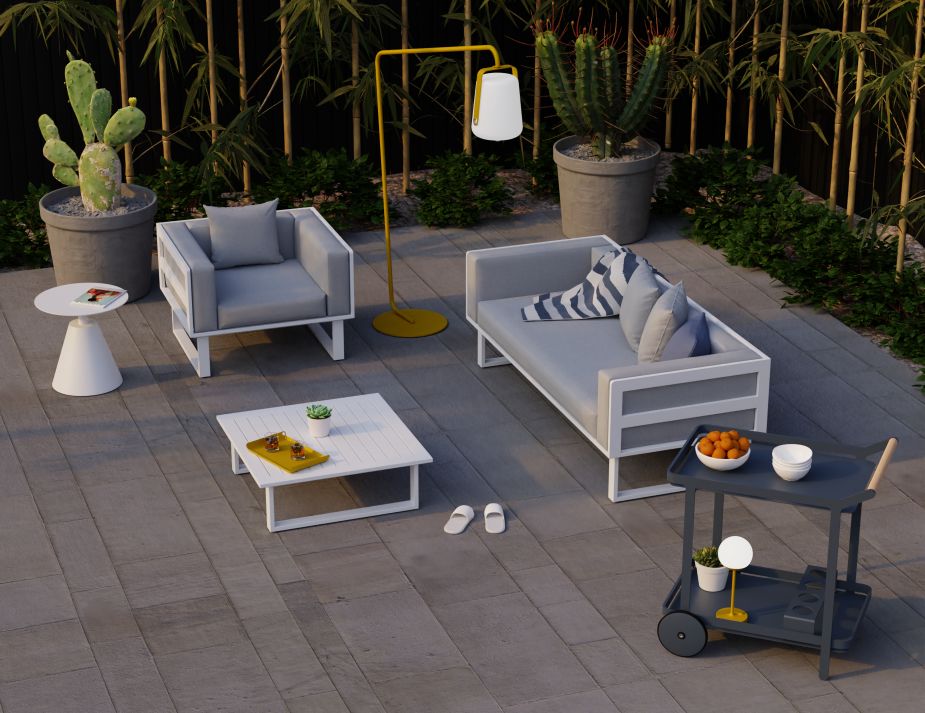
D. Navigating the Path of General Wear & Tear
Accidental Scuffs: Daily use can lead to unintentional scratches, dings, or minor damage to your outdoor furniture.
The Rust Problem: Metal furniture is especially susceptible to rust, which not only affects its appearance but also its durability.
Durability-Boosting Techniques:
Incorporating protective furniture pads into your maintenance routine can make a significant difference in preserving your furniture’s pristine condition. If you spot early signs of rust on your metal pieces, take swift action. Rust-resistant coatings can be transformative in restoring both the appearance and resilience of your furniture.

Top 10 Tips to Take Care of Your Outdoor Furniture
1) Invest in Quality Furniture Covers
To shield your outdoor furniture from the relentless forces of nature, high-quality furniture covers should be your first line of defence. These covers, meticulously designed to fit each piece accurately, become your ultimate guardians. They fend off the sun’s scorching rays, repel rain’s persistent embrace, block out dust’s unwelcome intrusion, and thwart the ever-present threat of pests. These are not just accessories; they are essential protectors, ensuring your outdoor patio furniture remains in impeccable condition.
2) Store Furniture Indoors During Winter
In regions where winter reigns with freezing temperatures and excessive moisture, the wisdom of indoor storage becomes evident. By granting your outdoor furniture a cosy indoor sanctuary during the cold months, you shield it from the potential damage wrought by frost and dampness. This simple act of protection extends the lifespan of your cherished outdoor pieces, ensuring they emerge from winter’s embrace unscathed.
3) Establish Regular Outdoor Furniture Cleaning Routines
The key to maintaining the allure of your outdoor furniture is the establishment of a regular cleaning regimen. Embrace the therapeutic act of cleansing with a mild dish soap and warm water solution. Leave no surface unattended, paying particular attention to crevices where dirt and grime seek refuge. After thoroughly cleaning your outdoor furniture, allow your furniture to bask in the sun’s warm embrace, air-drying to perfection.
4) Promptly Address Stains and Mould
Spills and stains are inevitable companions to outdoor living. When they occur, tackle them swiftly with a vinegar and water mixture. This dynamic duo is adept at cutting through stains like a seasoned professional. In cases of mould or mildew, a solution of bleach and water stands as your trusted ally. Always adhere to manufacturer recommendations to ensure a spotless victory.
5) Apply Protective Coatings
For your wooden furniture, an extra layer of defence in the form of varnish or sealant is a worthy investment. Periodically applying these protective coatings, especially before the onset of harsh weather seasons, preserves the natural allure of wood and bolsters its armour against the elements.
6) Consider Sanding and Refinishing
Should you encounter older wooden furniture showing signs of wear, don’t despair. Embark on a journey of revitalisation by sanding and refinishing. This transformative process breathes new life into your pieces, leaving them looking refreshed and ready for a new season.
7) Utilize Natural Pest Repellents
Creating a pest-free outdoor environment is a goal well within reach. Deterring insects is a breeze with eco-friendly options like citronella candles, essential oils, or herbs. These natural repellents provide a fragrant shield against unwanted guests, allowing you to enjoy your outdoor haven in peace.
8) Seek Professional Pest Control
For those confronting severe pest problems, consulting a professional pest control expert is a prudent step. These experts possess the knowledge and tools to safely and effectively eliminate pests without causing harm to your furniture or the environment.
9) Adjust Maintenance Based on Season
Customising your maintenance routine to the changing seasons is a strategy that pays dividends. In the summer, focus on protecting against sun damage and addressing heat-related issues. As winter approaches, prioritise indoor storage or the use of protective covers to safeguard your furniture from the rigours of the cold.
10) Regularly Check for Damage and Wear
Keeping a vigilant eye on your outdoor furniture for signs of damage, wear, or potential issues is a habit that reaps rewards. Addressing problems promptly prevents them from escalating, ensuring the longevity and pristine condition of your cherished pieces.
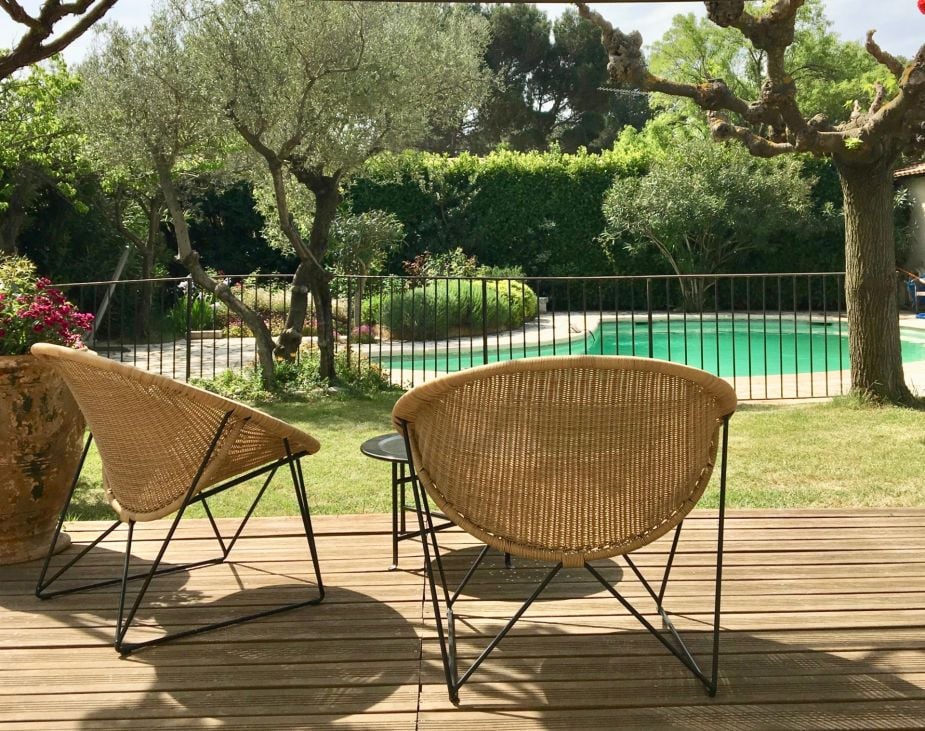
To Sum It Up: Your Outdoor Furniture Care Guidebook
As we wrap up this guide, it’s the perfect moment for reflexion. Your outdoor patio furniture is more than just functional decor; it’s the backdrop to countless cherished moments. Caring for it isn’t just about aesthetics; it’s about preserving those special experiences.
Recap of What We’ve Learnt about Outdoor Furniture Care:
We’ve delved into the significance of choosing materials that can withstand your specific climate and explored strategies for combating common challenges, from the relentless sun to pesky invaders. We’ve also dissected the nuances of regular maintenance and upkeep, as well as the added benefits of hands-on DIY outdoor furniture care.
Armed with these layered insights, you’re well-prepared to maintain your outdoor haven in top-notch condition. Enjoy every moment, from lazy sun-soaked afternoons to enchanting starlit evenings. Here’s to making each outdoor experience truly unforgettable.
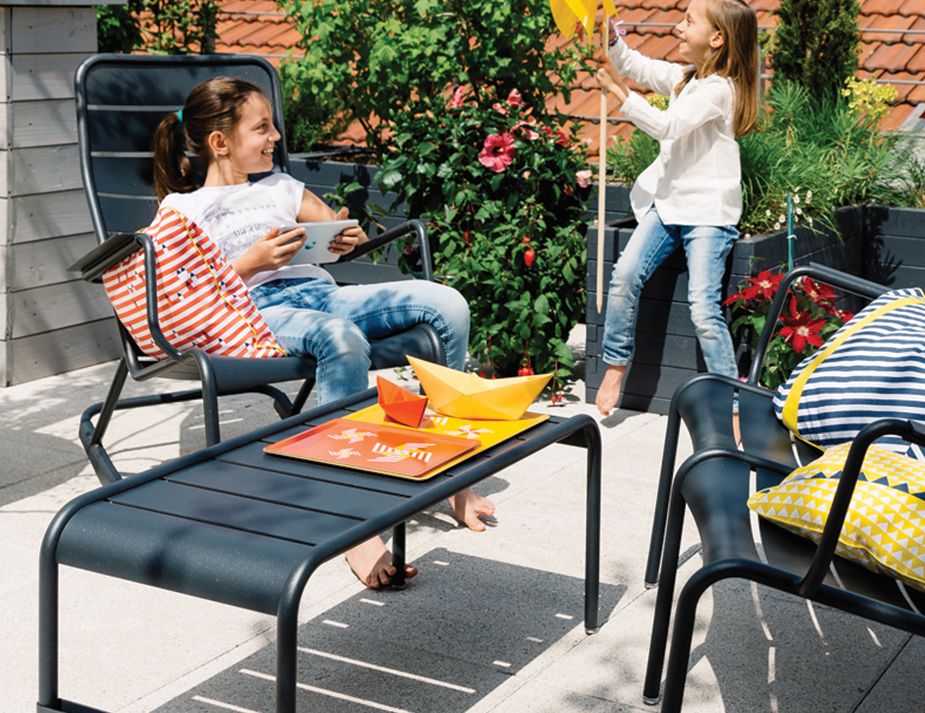
Frequently Asked Questions
Yes, consistent UV exposure can fade, weaken, and degrade most outdoor furniture materials. However, some materials, like UV-treated synthetic resins or UV-resistant fabrics, are designed to withstand sun damage better.
A mixture of warm water, mild detergent, and some white vinegar can help clean plastic furniture. For sun-faded or oxidized plastic, a specialized plastic restorer or automotive polish can rejuvenate the appearance.
Refreshing outdoor furniture often involves a good cleaning, possibly sanding down rough spots (for wood), and applying a new protective finish or paint. For metal, inspect for rust, clean thoroughly, and consider using a rust-inhibitive paint.
For metal furniture, light sanding followed by a protective finish can address oxidation. For plastic furniture showing signs of oxidation, automotive polish or specialized cleaners can help restore its original look.
Using water-resistant covers, applying protective sealants, and performing regular maintenance are effective methods. Store cushions indoors when not in use and consider using furniture glides to prevent water from standing on them.
